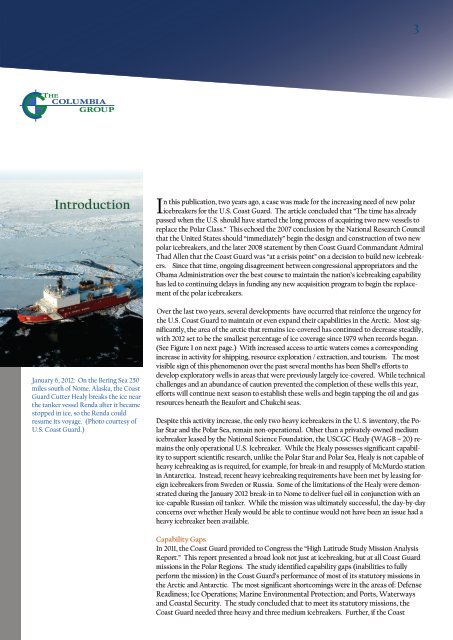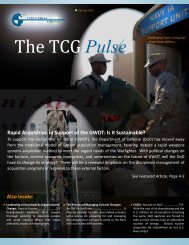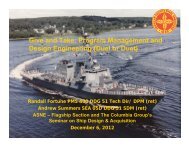Icebreaker Replacement - The Columbia Group
Icebreaker Replacement - The Columbia Group
Icebreaker Replacement - The Columbia Group
You also want an ePaper? Increase the reach of your titles
YUMPU automatically turns print PDFs into web optimized ePapers that Google loves.
3<br />
Introduction<br />
January 6, 2012: On the Bering Sea 250<br />
miles south of Nome, Alaska, the Coast<br />
Guard Cutter Healy breaks the ice near<br />
the tanker vessel Renda after it became<br />
stopped in ice, so the Renda could<br />
resume its voyage. (Photo courtesy of<br />
U.S. Coast Guard.)<br />
n this publication, two years ago, a case was made for the increasing need of new polar<br />
Iicebreakers for the U.S. Coast Guard. <strong>The</strong> article concluded that “<strong>The</strong> time has already<br />
passed when the U.S. should have started the long process of acquiring two new vessels to<br />
replace the Polar Class.” This echoed the 2007 conclusion by the National Research Council<br />
that the United States should “immediately” begin the design and construction of two new<br />
polar icebreakers, and the later 2008 statement by then Coast Guard Commandant Admiral<br />
Thad Allen that the Coast Guard was “at a crisis point” on a decision to build new icebreakers.<br />
Since that time, ongoing disagreement between congressional appropriators and the<br />
Obama Administration over the best course to maintain the nation’s icebreaking capability<br />
has led to continuing delays in funding any new acquisition program to begin the replacement<br />
of the polar icebreakers.<br />
Over the last two years, several developments have occurred that reinforce the urgency for<br />
the U.S. Coast Guard to maintain or even expand their capabilities in the Arctic. Most significantly,<br />
the area of the arctic that remains ice-covered has continued to decrease steadily,<br />
with 2012 set to be the smallest percentage of ice coverage since 1979 when records began.<br />
(See Figure 1 on next page.) With increased access to artic waters comes a corresponding<br />
increase in activity for shipping, resource exploration / extraction, and tourism. <strong>The</strong> most<br />
visible sign of this phenomenon over the past several months has been Shell’s efforts to<br />
develop exploratory wells in areas that were previously largely ice-covered. While technical<br />
challenges and an abundance of caution prevented the completion of these wells this year,<br />
efforts will continue next season to establish these wells and begin tapping the oil and gas<br />
resources beneath the Beaufort and Chukchi seas.<br />
Despite this activity increase, the only two heavy icebreakers in the U. S. inventory, the Polar<br />
Star and the Polar Sea, remain non-operational. Other than a privately-owned medium<br />
icebreaker leased by the National Science Foundation, the USCGC Healy (WAGB – 20) remains<br />
the only operational U.S. <strong>Icebreaker</strong>. While the Healy possesses significant capability<br />
to support scientific research, unlike the Polar Star and Polar Sea, Healy is not capable of<br />
heavy icebreaking as is required, for example, for break-in and resupply of McMurdo station<br />
in Antarctica. Instead, recent heavy icebreaking requirements have been met by leasing foreign<br />
icebreakers from Sweden or Russia. Some of the limitations of the Healy were demonstrated<br />
during the January 2012 break-in to Nome to deliver fuel oil in conjunction with an<br />
ice-capable Russian oil tanker. While the mission was ultimately successful, the day-by-day<br />
concerns over whether Healy would be able to continue would not have been an issue had a<br />
heavy icebreaker been available.<br />
Capability Gaps<br />
In 2011, the Coast Guard provided to Congress the “High Latitude Study Mission Analysis<br />
Report.” This report presented a broad look not just at icebreaking, but at all Coast Guard<br />
missions in the Polar Regions. <strong>The</strong> study identified capability gaps (inabilities to fully<br />
perform the mission) in the Coast Guard’s performance of most of its statutory missions in<br />
the Arctic and Antarctic. <strong>The</strong> most significant shortcomings were in the areas of: Defense<br />
Readiness; Ice Operations; Marine Environmental Protection; and Ports, Waterways<br />
and Coastal Security. <strong>The</strong> study concluded that to meet its statutory missions, the<br />
Coast Guard needed three heavy and three medium icebreakers. Further, if the Coast










![[x] amendment of solicitation/modification of contract - The Columbia ...](https://img.yumpu.com/26856860/1/190x245/x-amendment-of-solicitation-modification-of-contract-the-columbia-.jpg?quality=85)





